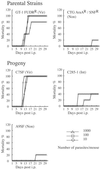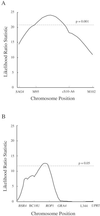Identification of quantitative trait loci controlling acute virulence in Toxoplasma gondii
- PMID: 12149482
- PMCID: PMC125035
- DOI: 10.1073/pnas.172117099
Identification of quantitative trait loci controlling acute virulence in Toxoplasma gondii
Abstract
Strains of Toxoplasma gondii can be grouped into three predominant clonal lineages with members of the type I group being uniformly lethal in mice. To elucidate the basis of this extreme virulence, a genetic cross was performed between a highly virulent type I strain (GT-1) and a less-virulent type III strain (CTG), and the phenotypes of resulting progeny were analyzed by genetic linkage mapping. Analysis of independent recombinant progeny identified several quantitative trait loci that contributed to acute virulence. A major quantitative trait locus located on chromosome VII accounted for approximately 50% of the virulence phenotype, whereas a minor locus on chromosome IV, linked to the ROP1 gene, accounted for approximately 10%. These loci are conserved in other type I strains, indicating that acute virulence is controlled by discrete genes common to the type I lineage.
Figures



Similar articles
-
Acute virulence in mice is associated with markers on chromosome VIII in Toxoplasma gondii.Infect Immun. 1996 Dec;64(12):5193-8. doi: 10.1128/iai.64.12.5193-5198.1996. Infect Immun. 1996. PMID: 8945565 Free PMC article.
-
Virulence differences in Toxoplasma mediated by amplification of a family of polymorphic pseudokinases.Proc Natl Acad Sci U S A. 2011 Jun 7;108(23):9631-6. doi: 10.1073/pnas.1015338108. Epub 2011 May 17. Proc Natl Acad Sci U S A. 2011. PMID: 21586633 Free PMC article.
-
Genetic approaches to studying virulence and pathogenesis in Toxoplasma gondii.Philos Trans R Soc Lond B Biol Sci. 2002 Jan 29;357(1417):81-8. doi: 10.1098/rstb.2001.1017. Philos Trans R Soc Lond B Biol Sci. 2002. PMID: 11839185 Free PMC article.
-
Toxoplasma gondii, "new" genotypes and virulence.Parasite. 2008 Sep;15(3):366-71. doi: 10.1051/parasite/2008153366. Parasite. 2008. PMID: 18814708 Review.
-
Differences among the three major strains of Toxoplasma gondii and their specific interactions with the infected host.Trends Parasitol. 2005 Oct;21(10):476-81. doi: 10.1016/j.pt.2005.08.001. Trends Parasitol. 2005. PMID: 16098810 Review.
Cited by
-
Reevaluation of the Toxoplasma gondii and Neospora caninum genomes reveals misassembly, karyotype differences, and chromosomal rearrangements.Genome Res. 2021 May;31(5):823-833. doi: 10.1101/gr.262832.120. Epub 2021 Apr 27. Genome Res. 2021. PMID: 33906964 Free PMC article.
-
The secreted kinase ROP18 defends Toxoplasma's border.Bioessays. 2011 Sep;33(9):693-700. doi: 10.1002/bies.201100054. Epub 2011 Jul 20. Bioessays. 2011. PMID: 21773979 Free PMC article. Review.
-
Effective factors in the pathogenesis of Toxoplasmagondii.Heliyon. 2024 May 19;10(10):e31558. doi: 10.1016/j.heliyon.2024.e31558. eCollection 2024 May 30. Heliyon. 2024. PMID: 38818168 Free PMC article. Review.
-
Analysis of Noncanonical Calcium-Dependent Protein Kinases in Toxoplasma gondii by Targeted Gene Deletion Using CRISPR/Cas9.Infect Immun. 2016 Apr 22;84(5):1262-1273. doi: 10.1128/IAI.01173-15. Print 2016 May. Infect Immun. 2016. PMID: 26755159 Free PMC article.
-
Networks Underpinning Symbiosis Revealed Through Cross-Species eQTL Mapping.Genetics. 2017 Aug;206(4):2175-2184. doi: 10.1534/genetics.117.202531. Epub 2017 Jun 22. Genetics. 2017. PMID: 28642272 Free PMC article.
References
-
- Dubey J. P. (1994) J. Am. Vet. Med. Assoc. 205, 1593-1598. - PubMed
-
- Dardé M. L., Bouteille, B. & Pestre-Alexandre, M. (1992) J. Parasitol. 78, 786-794. - PubMed
-
- Howe D. K. & Sibley, L. D. (1995) J. Infect. Dis. 172, 1561-1566. - PubMed
-
- Sibley L. D. & Boothroyd, J. C. (1992) Nature (London) 359, 82-85. - PubMed
Publication types
MeSH terms
Grants and funding
LinkOut - more resources
Full Text Sources
Other Literature Sources
Miscellaneous

